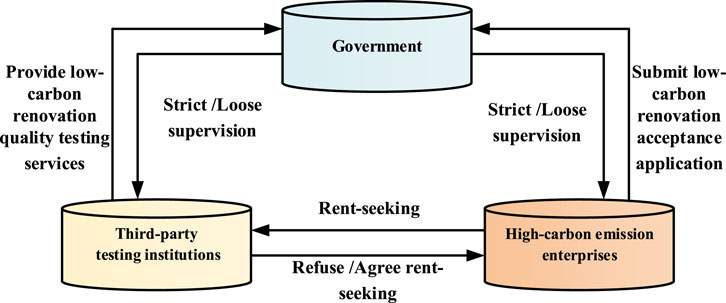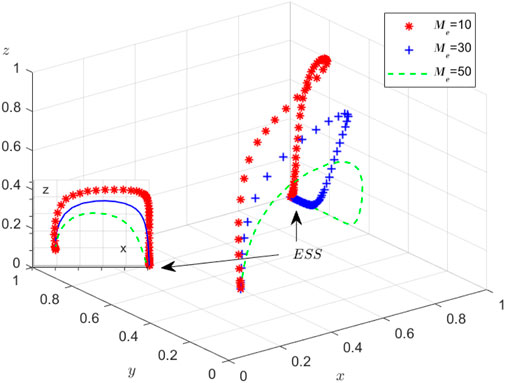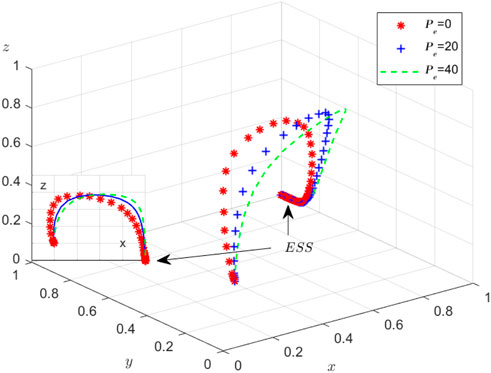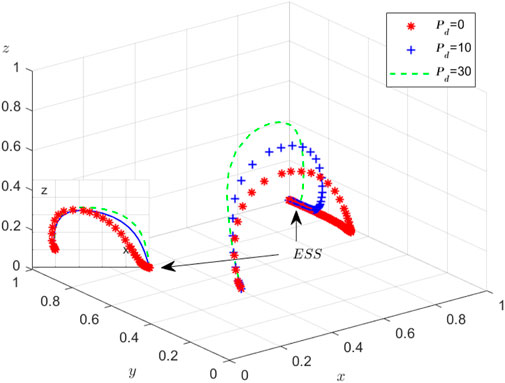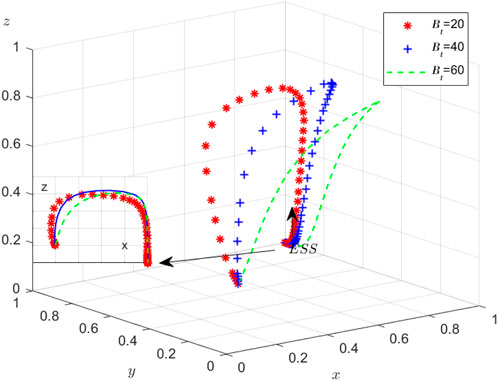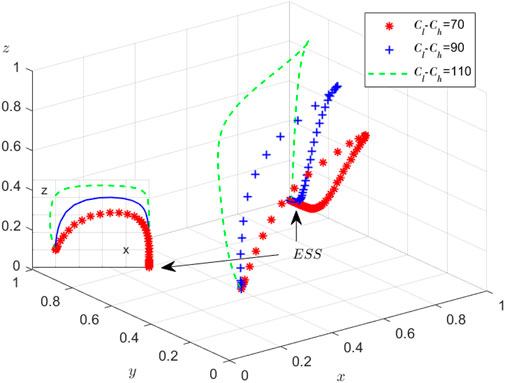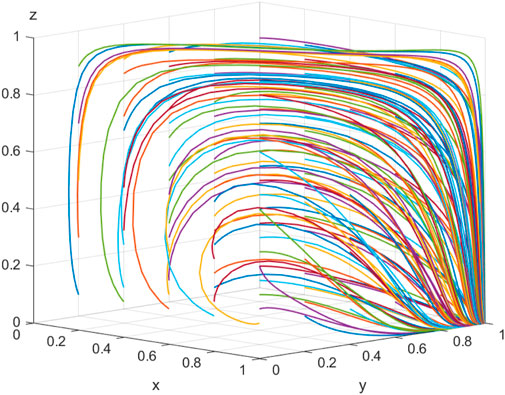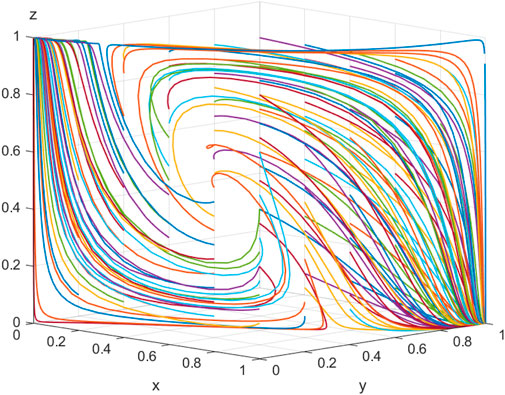- 1School of Economics and Management, Beijing University of Posts and Telecommunications, Beijing, China
- 2China Railway Construction Investment Group Co., Ltd., Beijing, China
From the perspective of multi-stakeholders, considering the rent-seeking phenomenon existing in the inspection and acceptance of low-carbon renovation under the government’s reward and punishment mechanism, this paper constructs a tripartite evolutionary game model of the government, third-party testing institutions, and high-carbon emission enterprises, analyzes the stability of the evolutionary strategies of all parties involved, and tests the influence of the reward and punishment mechanism, rent-seeking cost, and the cost difference between high carbon and low carbon on the choice of tripartite strategies through simulation. Finally, the stability of the equilibrium point in the tripartite game system is verified. The results show that 1 the government’s increase in the reward and punishment mechanism will promote the low-carbon renovation of high-carbon emission enterprises and the refusal to rent-seeking behavior choices, but the increase in incentives will weaken the government’s supervision; 2 the reward and punishment mechanism set by the government must meet the condition that the sum of the strength of the reward and punishment mechanism for each party is greater than its speculative income, so as to ensure the quality of low-carbon renovation of high-carbon emission enterprises; 3 the greater the rent-seeking cost paid by high-carbon emission enterprises, the more conducive it is to avoiding the unqualified low-carbon renovation of high-carbon emission enterprises; and 4 under the premise of certain sales revenue, the greater the cost difference between low-carbon production and high-carbon production, the lower the willingness of enterprises to low-carbon renovation. Therefore, reducing the production cost difference is an effective way to promote the low-carbon renovation of high-carbon emission enterprises.
1 Introduction
According to the China’s Listed Companies Carbon Emissions List (2022) released in September 2022, China’s total carbon emissions in 2021 exceeded 10.3 billion tons, accounting for about 27% of the total global carbon emissions. The 100 listed companies, total carbon emissions of about 5.1 billion tons, account for about 49.5% of the total. The total carbon emissions of the top 10 enterprises are more than 150 million tons, accounting for about 44% of the total emissions. The total emissions of these traditional high-carbon emission enterprises such as electricity, petrochemical, and coal are almost close to the total emissions of all the remaining enterprises. It can be seen that the low-carbon renovation of traditional high-carbon emission enterprises is the key path to realize the green and low-carbon renovation of the economy (Yunchao et al., 2022), which is the requirement of high-quality economic development and the proper meaning of China’s participation in global governance. Since 2022, Chinese governments have promulgated a series of relevant policies and regulations to encourage low-carbon renovation of traditional industries and support environmentally sustainable development. For example, in December 2022, the Beijing State-owned Assets Supervision and Administration Commission issued the “action plan for carbon peaking of municipal enterprises” proposing the low-carbon renovation of high-carbon emission enterprises. This is an important way to transform the industrial structure and accelerate the low-carbon cycle transformation of own property and industrial parks. It is required to focus on public buildings such as office buildings, hotels, and commercial supermarkets to carry out energy efficiency assessments and take the lead in promoting low-carbon renovation of existing buildings that meet the conditions. As an auxiliary force of the government in the professional field, third-party testing institutions are prone to rent-seeking behavior driven by interests. For example, in November 2022, the Shanghai Municipal Government notified four institutions in Shanghai of fraud in activities related to environmental monitoring services. At the same time, the Anhui Provincial Department of Ecology and Environment notified eight typical cases of third-party environmental testing agencies falsifying detection data in Anhui Province.
However, the overall atmosphere of low-carbon renovation of China’s high-carbon emission enterprises has not yet been formed (Tingting and Shuhui, 2022). From the perspective of the production side of carbon emissions, traditional high-carbon emission enterprises have profit-seeking motives (Guo and Huang, 2021). Focusing on short-term interest balance, low-carbon renovation is insufficient. In the absence of government guidance, they usually choose to maintain high-carbon production strategies to save total production costs. From the perspective of government supervision, in order to encourage high-carbon emission enterprises to carry out low-carbon renovation, the government will formulate a reward and punishment mechanism for low-carbon renovation of high-carbon emission enterprises to cultivate and guide high-carbon emission enterprises to implement low-carbon renovation. However, in reality, due to the lack of government supervision in the professional field, the reward and punishment mechanism is difficult to fundamentally implement (Wang et al., 2022; Ziming et al., 2022); from the perspective of professional testing guarantee, the third-party testing institutions, as an auxiliary force to make up for the lack of government supervision ability in the professional field (Bin et al., 2020), become the judge of whether the high-carbon emission enterprises complete the low-carbon renovation. Driven by the interests, the third-party testing institutions have the risk of agreeing to rent-seeking (Liu et al., 2020; Lv et al., 2022), resulting in the low-carbon renovation quality of high-carbon emission enterprises failing to meet the government‘s requirements. Through the literature review and existing policy review, it is found that most of the low-carbon renovation policy documents on existing facilities are issued in 2022. However, the existing research mainly focuses on the evaluation of low-carbon renovation and the research on low-carbon emission reduction strategies of enterprises (Qu et al., 2021; Bai and Zhang, 2022; Jiang et al., 2020b; Dong et al., 2021). The research on the low-carbon renovation of high-carbon emission enterprises has only begun to receive attention recently, and related research has begun to expand. In order to fill this research gap, this paper explores the quality supervision of low-carbon renovation of high-carbon emission enterprises under the government reward and punishment mechanism, which has a guiding significance for improving the quality of low-carbon renovation of high-carbon emission enterprises.
Through the aforementioned analysis, it can be seen that there is information asymmetry among the government, high-carbon emission enterprises, and third-party testing institutions, which is a non-cooperative game relationship. Compared with the traditional game theory, the evolutionary game is based on the bounded rationality of decision makers and does not require complete information conditions (ShengYuan et al., 2022). Evolutionary game analysis with multi-agent participation is more helpful to reveal complex problems (Feng et al., 2020; Xie et al., 2022). Studies have confirmed the effectiveness of evolutionary games in the study of quality supervision. Therefore, the evolutionary game is an effective method to study the dynamic change of multi-agent strategy under bounded rationality, which is suitable for the quality supervision of low-carbon renovation studied in this paper. In this paper, the evolutionary game between the government, high-carbon emission enterprises, and third-party testing institutions can be expressed as follows: in order to promote the low-carbon renovation of high-carbon emission enterprises, the government formulates policies on the reward and punishment mechanism to supervise the quality of low-carbon renovation. Based on the maximization of benefits, enterprises and third-party testing institutions will change with the intensity and cost of rewards and punishments, and behavioral strategies will change dynamically.
This paper answers the following key questions:
1) How does the government’s reward and punishment mechanism affect the strategic choice of high-carbon emission enterprises and third-party testing institutions?
2) What kind of reward and punishment mechanism can ensure the quality of low-carbon renovation of high-carbon emission enterprises?
3) How does rent-seeking behavior affect the strategic choice of high-carbon emission enterprises and third-party testing institutions?
4) How should the government respond effectively to the impact of the difference between the cost of low-carbon retrofit and the cost of high-carbon production on the strategic choices of high-carbon emission enterprises?
The remainder of the paper is organized as follows. Section 2 reviews related research; Section 3 proposes research hypotheses and constructs an evolutionary game model; Section 4 analyzes the stability of the evolutionary game strategy; Section 5 analyzes the influence of key variables on game equilibrium; and Section 6 provides conclusion, suggestions, and limitations.
2 Literature review
At present, there are two different research ideas on the low-carbon renovation of enterprises at home and abroad: to study the impact of low-carbon renovation behavior on the behavior strategies of all parties on low-carbon development from the perspective of stakeholders and from the perspective of empirical research to study the impact of low-carbon business transformation factors. Based on the first research idea, this paper explores the quality supervision of low-carbon renovation of high-carbon emission enterprises.
The research on the behavior strategy of low-carbon renovation of enterprises mainly focuses on the relationship between the government and enterprises, and the research based on game theory is particularly extensive. In the study of government policies on low-carbon renovation of enterprises (Du et al., 2021; Caijiang et al., 2022; Chen et al., 2022; Huo et al., 2022; Shi et al., 2022), this study analyzes the impact of government environmental policies on low-carbon renovation of enterprises and puts forward relevant suggestions. Fan et al. (2021) studied the problem of overcapacity in coal enterprises under government environmental supervision and concluded that environmental supervision helped low-carbon production in the coal industry. Wan et al. (2021) and Hu and Wang (2022) believed that the government subsidy mechanism can promote low-carbon development. Gao et al. (2022) proposed that the behavior of enterprises depends on the benefits of green innovation and the losses without green innovation. Li (2022) found that the low-carbon behavior of construction enterprises depends on the construction income and government reward and punishment policies. Such research studies can be used as a reference, but only the two stakeholders of government and enterprises are considered, ignoring the impact of other stakeholders on low-carbon renovation.
In the research of low-carbon renovation of traditional high-carbon emission enterprises, Wang et al. (2020), Li et al. (2022), and Shao xiong et al. (2022) constructed a dynamic game model of the evolution and development of enterprise carbon emission reduction and proposed enterprise carbon emission reduction strategies. Cui (2022), Cui (2019), and Yang et al. (2022) proposed that enterprise innovation is the key for high-carbon emission enterprises to determine the effect of carbon emission reduction. Wang and Zhang (2022) examined the role of the carbon emission trading mechanism in the low-carbon renovation of high-carbon emission enterprises. Qu and Sun (2022) and Suyong et al. (2021) proposed the role of flexible carbon tax policy in promoting energy conservation and emission reduction of high-carbon emission enterprises. Jiang et al. (2020a) and Liu et al. (2022) decomposed the influencing factors of low-carbon renovation of high-carbon emissions and proposed that innovation is crucial to green transformation and development. The research on low-carbon renovation of high-carbon emission enterprises is abundant, but the research direction is mostly transformation strategy and influencing factors, and there is lack of research on quality supervision of low-carbon renovation.
In the field of quality supervision (Xu et al., 2021), the evolutionary game method is applied to the study of inland waterway pollution regulation. He et al. (2021) and Wen et al. (2021) studied the quality supervision of online shopping from the perspective of government regulation by using evolutionary game theory. Yang et al. (2021) built an evolutionary game model of the government, contractors, and the public to study the problem of project quality supervision. Sun et al. (2022) constructed an evolutionary game model based on prospect theory to study carbon emission regulation. Xia et (al. studied the quality control of automobile recalls, emphasizing the supervisory role of public opinion. The aforementioned research shows that the evolutionary game is applicable in the field of quality regulation, but ignores the role of third-party professional institutions in quality regulation. Through the aforementioned research, it can be seen that the evolutionary game has made many explorations in the field of quality supervision, but no research has applied it to the quality supervision of low-carbon renovation.
In summary, many scholars have used evolutionary game methods to study and explore government supervision, low-carbon renovation of enterprises, and quality supervision, which provides a rich research basis for this study. The differences between this article and related literature are mainly as follows:
1) Considering the role of third-party professional institutions in quality supervision, this paper constructs a tripartite evolutionary game model among high-carbon emission enterprises, third-party testing institutions, and governments and studies the three parties within the analytical framework
2) This paper studies the impact of the reward and punishment mechanism on the quality of low-carbon renovation of high-carbon emission enterprises and innovates research perspectives
3) Considering the rent-seeking behavior between third-party testing institutions and enterprises, this paper discusses its impact on the quality supervision of low-carbon renovation
3 Methods and materials
The participation of third-party testing institutions is a guarantee for traditional high-carbon emission enterprises to complete low-carbon renovation according to the standards set by the government. The logical relationship between the three evolutionary game stakeholders of low-carbon renovation quality supervision of high-carbon emission enterprises constructed in this paper is shown in Figure 1.
3.1 Model assumptions
Assumption 1. High-carbon emission enterprise is participant 1, the third-party testing organization is participant 2, and the government is participant 3, the three parties are participants with bounded rationality, and the choice of strategy is stable in the optimal strategy over time.
Assumption 2. High-carbon emission enterprises, third-party testing institutions, and government have two kinds of behavior choices, that is, whether high-carbon emission enterprises carry out low-carbon renovation,
Assumption 3. High-carbon emission enterprises need to be tested by third-party testing institutions. Enterprises that can meet the standards will continue to produce, and enterprises that do not meet the standards will be closed down and unable to continue production and operation. Therefore, all high-carbon emission enterprises must pass the inspection and acceptance of third-party testing institutions to maintain the normal production and operation of enterprises. If high-carbon emission enterprises choose a high-carbon production strategy, in order to maintain production, it will seek rent from a third-party testing agency to meet the requirements of the environmental protection department. If the quality of low-carbon renovation of high-carbon emission enterprises is not so thorough, the quality of renovation has certain defects. The production strategy of enterprises is still high-carbon production. If high-carbon emission enterprises choose a low-carbon production strategy and the low-carbon renovation meets the needs of the government, they will not seek rent from third-party testing institutions.
Assumption 4. The sales revenue of high-carbon emission enterprises is R, the low-carbon production cost is
Assumption 5. The test income of third-party testing institutions is B. If the third-party testing institutions have rent-seeking intentions, regardless of whether the high-carbon emission enterprises have rent-seeking needs or not, the third-party testing institutions will have certain non-material costs due to rent-seeking intentions. In fact, the non-material cost of third-party testing institutions is much greater than the material cost of their participation in rent-seeking. Therefore, in this paper, if the third-party testing agency chooses the intention rent-seeking strategy, it will generate rent-seeking costs, and the rent-seeking of the third-party testing agency is
Assumption 6. When the government adopts a strict regulatory strategy, the regulatory cost is
Assumption 7. The low-carbon renovation of high-carbon emission enterprises is conducive to the improvement of the social environment and government credibility and brings social benefits to the government, that is,
3.2 Model construction
According to the aforementioned assumptions, a tripartite mixed game strategy matrix of high-carbon emission enterprises, third-party testing institutions, and government is constructed, as shown in Table 1.
4 Model analysis
4.1 Strategy stability analysis of high-carbon emission enterprises
The expected revenue of high-carbon emission enterprises for low-carbon production and high-carbon production is
Replicated dynamic equation:
First derivative of
Suppose
According to the stability theorem of differential equations, the probability of low-carbon production in high-carbon emission enterprises must satisfy
It can be seen from the phase diagram that the probability of stable high-carbon production of high-carbon emission enterprises is the volume of
Proposition 1. The probability of high-carbon emission enterprises choosing high-carbon production is negatively related to the rent-seeking cost of high-carbon emission enterprises and the reward and punishment of high-carbon emission enterprises by the government. It is positively correlated with the cost difference between low-carbon production and high-carbon production.
Proof. The difference in the production cost is the key factor for high-carbon emission enterprises to decide whether to carry out low-carbon transformation. If the difference in production costs is lower than the cost of rent-seeking, then there is no need for enterprises to participate in rent-seeking behavior, which has no practical significance. Therefore, the difference in production costs must be greater than its rent-seeking cost. So, we can obtain
Proposition 1 shows that the government can also expand the rewards and punishments of high-carbon emission enterprises, which can effectively promote the willingness of high-carbon emission enterprises to carry out low-carbon renovation. At the same time, it can expand the rent-seeking cost of high-carbon emission enterprises through information construction, production qualification degradation, credit assessment, and other ways and can also promote the low-carbon transformation of high-carbon emission enterprises. In addition, from the perspective of production links, the use of market mechanisms to reduce the cost difference between low-carbon production costs and high-carbon production costs can also effectively promote the low-carbon transformation of high-carbon emission enterprises.
Proposition 2. In the process of evolution, the probability of high-carbon emission enterprises choosing low-carbon production increases with the increase in the probability of third-party testing institutions refusing rent-seeking and the probability of strict supervision by the government.
Proof. When
Proposition 2 shows that the increase in the probability of third-party testing institutions refusing rent-seeking is conducive to the stable strategy of high-carbon emission enterprises choosing low-carbon production. This shows that the government, as a regulatory department, can not only promote the green transformation of high-carbon emission enterprises by improving its own strict supervision measures but also cultivate the social responsibility of third-party testing institutions, improve their fairness, and give full play to their testing and supervision effectiveness, which is conducive to the improvement of the quality of low-carbon renovation.
4.2 Strategy stability analysis of third-party testing institutions
The expected revenue of third-party testing institutions refusing rent-seeking and agreeing rent-seeking is
Replicated dynamic equation:
First derivative of
Hypothesis 1.
Proposition 3. The probability of third-party testing institutions choosing rent-seeking is positively correlated with the rent-seeking cost of high-carbon emission enterprises and negatively correlated with their speculative cost and the government’s reward and punishment for third-party testing institutions.
Proof. Calculating the first-order partial derivative of each element of the probability
Proposition 3 shows that when the third-party testing institutions have large speculative gains, the government should increase rewards and punishments and expand their speculative costs through media publicity, qualification downgrades, and other means, which will help reduce the rent-seeking behavior of third-party testing institutions.
Proposition 4. In the process of evolution, the probability of third-party testing institutions refusing rent-seeking increases with the increase in government strict supervision or the probability of high-carbon emission enterprises choosing low-carbon production.
Proof: when
Proposition 4 shows that the choice of third-party testing institutions to refuse rent-seeking strategy is affected by the government’s supervision or the choice of low-carbon production strategy by high-carbon emission enterprises. In other words, the government strengthens supervision, and the quality of low-carbon renovation of high-carbon emission enterprises reaches the standard, which can promote third-party testing institutions to refuse rent-seeking. Therefore, in order to ensure the objective fairness of the third-party testing institutions, the government needs strict regulatory measures, while ensuring the quality of low-carbon renovation of high-carbon emission enterprises.
4.3 Strategic stability analysis of government supervision
The expected revenue of the government choosing strict regulation and loose regulation is
Replicated dynamic equation:
First derivative of
Hypothesis 2.
Proposition 5. The probability that the government chooses strict supervision is negatively correlated with its reward and punishment for third-party testing institutions, supervision cost, and reward for enterprises and positively correlated with the punishment of higher authorities and the punishment of enterprises and third-party testing institutions
Proof. Calculating the first-order partial derivative of each element of the probability
Proposition 5 shows that the greater the punishment set by the government, the more it can promote the low-carbon renovation of high-carbon emission enterprises, but its supervision will be weakened. Increased incentives for high-carbon emission enterprises and third-party testing machine are conducive to third-party testing institutions to remain neutral to protect the quality of low-carbon renovation of high-carbon emission enterprises.
Proposition 6. In the evolution process, the probability of strict government supervision decreases with the probability of third-party testing institutions refusing rent-seeking or the probability of high-carbon emission enterprises choosing low-carbon production.
Proof. When
Proposition 6 shows that the probability of strict government supervision is affected by the strategic choice of third-party testing institutions and high-carbon emission enterprises. When the third-party testing institutions with higher fairness or high-carbon emissions enterprises choose low-carbon renovation, the government’s strict supervision will decline, prone to regulatory deficiencies.
4.4 Strategy stability analysis of the tripartite evolutionary game
By analyzing the evolution of the strategy selection of the whole evolution system, the equilibrium point of the system can be obtained from
Due to
where
In the tripartite replication dynamic system,
Proposition 7. When the rent-seeking cost of high-carbon emission enterprises is greater than the speculative cost of third-party testing institutions and the government’s reward and punishment for it, the sum of the production cost difference and the rent-seeking cost is higher than the sum of the government’s reward and penalty, the replicator dynamic system has a stable point
Proof. When the rent-seeking cost of high-carbon emission enterprises is greater than the speculative cost of third-party testing institutions and the government‘s reward and punishment, where
Proposition 7 shows that when the government‘s rewards and punishments for third-party testing institutions and high-carbon emission enterprises are relatively small and the speculative gains when enterprises and third-party testing institutions choose rent-seeking strategies are high, according to the different initial points of the three-party strategy selection, the evolution of the strategy portfolio is stable at (high-carbon production, rent-seeking, and strict supervision) and (low-carbon production, refuse rent-seeking, and loose supervision). At this time, the regulatory effectiveness of the government has declined, and high-carbon production enterprises and third-party testing institutions easily form a cooperative relationship, resulting in poor quality of low-carbon renovation. In order to avoid the emergence of such phenomena, the government should increase the intensity of rewards and punishments and test the effectiveness of the reward and punishment mechanism.
Proposition 8. When the reward and punishment for third-party testing institutions and high-carbon emission enterprises is greater than their speculative income, the sum of the difference in production costs and rent-seeking costs of enterprises is higher than the government’s reward and punishment, and the replicator dynamic system has only one equilibrium point
Proof. When the rewards and punishments for third-party testing institutions and high-carbon emission enterprises are greater than their speculative gains, where
Proposition 8 shows that the government’s rewards and punishments for third-party testing institutions and high-carbon emission enterprises are greater than their speculative gains, so as to effectively prevent the emergence of (high-carbon production, rent-seeking, and strict supervision) strategy combinations. At this time, the government’s reward and punishment for high-carbon emission enterprises should be greater than their production cost difference and rent-seeking cost, while the reward and punishment for third-party testing institutions should be greater than their speculative income. Thus, a reasonable reward and punishment mechanism can effectively promote the low-carbon renovation of high-carbon emission enterprises and can constrain the rent-seeking behavior of third-party testing institutions to protect the quality of low-carbon renovation.
5 Simulation analysis
The Chinese government has provided many positive policies for low-carbon renovation, and it has also introduced many negative policies for traditional high-carbon industries, including providing R&D subsidies for low-carbon renovation, upgrading low-carbon supporting facilities and infrastructure, increasing carbon tax, and encouraging high-carbon emission enterprises. Low-carbon renovation gives priority to the development of low-carbon industries. For example, in January 2023, the Industrial and Information Bureau of Jinan City, Shandong Province, announced a list of enterprises that received financial incentives for industrial green development. ZTJ Group’s Construction Technology Co., Ltd., is rewarded by the government department. The company’s main business scope is the research and development of new technologies for building materials and the production of traditional building materials. According to the requirements of the local government, the company has implemented low-carbon renovation since 2021, developed new green technologies, and improved production processes. At the end of 2022, the low-carbon renovation of building material production was basically completed, and it obtained the government’s green development incentive funds of 200,000 Yuan. Based on the aforementioned background, this paper takes the low-carbon renovation of traditional high-carbon emission industries in China as the research background and studies the quality supervision of low-carbon renovation of high-carbon emission enterprises under the government reward and punishment mechanism.
In order to verify the effectiveness of the evolutionary stability analysis, this paper refers to the research results of Yue and Lin (2019), Xu et al. (2021), and Liu et al. (2021) and combines the reality to assign the model. The case is based on the low-carbon renovation of the boiler burner of ZTJ Group Construction Technology Co., Ltd. The cost of the production line after the low-carbon renovation is about 960,000 CNY higher than that before the renovation. In order to facilitate the calculation, the production cost difference is 90. As mentioned previously, after the completion of the low-carbon renovation, the local government awards 200,000 CNY, taking into account the increase in its social benefits, the total income value of 350,000 CNY. Therefore, the parameter for high-carbon emission enterprises rewards is 35. Referring to the work of Xi’an, the government gives each annual 200,000–500,000 CNY incentive policy for no bad business behavior of the third-party inspection and testing institutions; the parameter for third-party testing institution rewards is 25. According to the assumption that the rent-seeking cost should be lower than the government’s reward for enterprises and the cost of renovation and much higher than the government’s reward for third-party testing institutions, the rent-seeking cost parameter is valued at 40. The fundamental purpose of the government’s reward and punishment mechanism is to encourage high-carbon emission enterprises to carry out low-carbon renovation. Therefore, the punishment parameters are assigned according to the principle that the punishment is lower than the reward. This study uses MATLAB 2022a software to simulate the data. Array 1
5.1 Influence of the reward and punishment mechanism on system evolution
5.1.1 Rewards and punishments for high-carbon emission enterprises on system evolution
In order to investigate the influence of the reward intensity of low-carbon renovation of high-carbon emission enterprises on the process and results of evolutionary game, the government’s reward
Figure 5 shows that in the process of evolution to a stable point, the increase in the reward amount for low-carbon renovation of high-carbon emission enterprises can accelerate the evolution speed of their low-carbon renovation. With the increase in the reward amount, the supervision of government regulatory departments will be reduced, and the probability of third-party testing institutions refusing rent-seeking will increase. Therefore, the government should strengthen the supervision of the quality of low-carbon renovation while increasing the incentives for low-carbon renovation to promote the low-carbon renovation of high-carbon emission enterprises. In the process, the supervision role of third-party testing institutions can be appropriately played to ensure the quality of low-carbon renovation.
In order to investigate the influence of the punishment of high-carbon production of high-carbon emission enterprises on the process and results of evolutionary game, the government’s punishment
Figure 6 shows that the increase in the penalty amount of high-carbon production can promote enterprises to carry out low-carbon renovation, but the evolution speed is lower than that of the reward mechanism. With the increase in the penalty amount, based on the consideration of the penalty income, the government tends to strictly supervise. Therefore, when promoting low-carbon renovation of enterprises, the government should formulate a reasonable reward–punishment mechanism, implement the strategy of giving priority to the reward mechanism and supporting the punishment mechanism, and increase the subjective will of low-carbon renovation of enterprises.
5.1.2 Influence of reward and punishment of third-party testing institutions on system evolution
In order to investigate how the reward for third-party testing institutions affects the evolutionary game process and results, the government’s reward
Figure 7 shows that the increase in the government’s reward for third-party testing institutions to refuse rent-seeking will increase the probability of refusing rent-seeking, but the probability of strict supervision will decrease. Therefore, the government should formulate a reasonable reward and punishment mechanism when hiring third-party testing institutions, take rewards as part of their service fees, strengthen their assessment, and effectively protect the fairness of third-party testing institutions.
In order to investigate how the punishment for rent-seeking of third-party testing institutions affects the evolutionary game process and results, the government’s punishment
Figure 8 shows that as the government’s penalty for rent-seeking by third-party testing institutions increases, the probability of refusing rent-seeking also increases, while the probability of low-carbon renovation of high-carbon emission enterprises and the probability of strict government supervision increase. Therefore, the punishment of third-party testing institutions to protect the impartiality of third-party testing institutions is an important measure to promote the low-carbon renovation of high-carbon emission enterprises.
5.2 Influence of rent-seeking cost on system evolution
In order to investigate the influence of rent-seeking cost of high-carbon emission enterprises on the process and result of evolutionary game, the rent-seeking cost
Figure 9 shows that in the process of evolution, with the increase in rent-seeking costs of high-carbon emission enterprises, government supervision has not changed much, but the probability of low-carbon renovation has increased, while the probability of third-party testing institutions refusing rent-seeking has decreased. Therefore, the government can increase the cost of rent-seeking and reduce the probability of rent-seeking by increasing rewards and punishments for third-party testing institutions and enterprises, reducing production qualification and managing negative lists.
5.3 Influence of enterprise production cost difference on the evolutionary system
In order to investigate the influence of the difference between the production cost after the low-carbon renovation of high-carbon emission enterprises and the high-carbon production cost on the evolutionary game process and results, the difference
Figure 10 shows that in the process of evolution, with the increase in the production cost difference, the probability of strict government supervision increases, while the probability of enterprises choosing low-carbon renovation decreases. Therefore, under the premise of certain sales revenue, the difference in the production cost is the key factor for high-carbon emission enterprises to carry out low-carbon renovation, which is also one of the restrictive factors for the low-carbon renovation of most high-carbon emission enterprises. The system evolution results show that the government can reduce the production cost difference by adopting subsidies and tax incentives and improving industrial supporting services. Enterprises can improve production efficiency and reduce production cost difference through technological innovation and supply chain optimization, forming a benign closed loop of mutual support between enterprises and the government.
5.4 Stability analysis of the evolutionary strategy
Array 1 satisfies the conditions in Proposition 8. To verify the stability of the evolutionary strategy, array 2
As shown in Figure 11, under the condition of satisfying Proposition 8, array 1 has only one evolutionary stable strategy
6 Conclusion
6.1 Research conclusion and suggestions
Under the government reward and punishment mechanism, the possible rent-seeking behavior between high-carbon emission enterprises and third-party testing institutions in the process of low-carbon renovation quality acceptance is considered. A tripartite evolutionary game model was constructed between the government, high-carbon emission enterprises, and third-party testing institutions to analyze the stability of the strategy selection of all parties and the stability of the equilibrium strategy combination of the game system. This paper explores the influence of the government’s reward and punishment mechanism, rent-seeking cost, and production cost difference on the evolution of the game system and verifies the validity of the analysis conclusion by MATLAB 2022a numerical simulation. The conclusions of this paper are as follows:
1) The increase in the reward and punishment mechanism on the government side will promote the low-carbon renovation of high-carbon emission enterprises and the strategic choice of third-party testing institutions to refuse rent-seeking, but the increase in the reward will reduce the probability of strict government supervision, which is not conducive to the government’s performance of regulatory duties and is prone to inadequate supervision.
2) A reasonable reward and punishment mechanism can effectively promote the low-carbon renovation of high-carbon emission enterprises and regulate the behavior of third-party testing institutions, but the government in the development of the reward and punishment mechanism must be combined with the actual situation of the parties. The sum of the reward and punishment mechanism for high-carbon emission enterprises should be higher than the sum of production cost difference and rent-seeking cost. The sum of the reward and punishment mechanism for third-party testing institutions should be greater than their speculative income, so as to ensure the quality of low-carbon renovation of high-carbon emission enterprises.
3) The higher the cost of rent-seeking, the higher the probability of third-party testing institutions choosing rent-seeking behavior, which is not conducive to government regulation of the quality of low-carbon renovation. The government can curb rent-seeking behavior by increasing the amount of penalties, degrading production qualifications, and managing negative lists, which is also an effective way to avoid substandard low-carbon renovation quality.
4) Under the premise of certain sales revenue, the cost difference between low-carbon production and high-carbon production is the key factor for enterprises to decide whether to carry out low-carbon renovation. The greater the production cost difference, the lower the willingness of enterprises to carry out low-carbon renovation. The government can reduce the difference in production costs by means of subsidies and tax incentives and improve industrial supporting services; enterprises can improve production efficiency, reduce production cost difference, and achieve a win–win situation between the government and enterprises through technological innovation and optimization of supply chain.
Based on the research results, under the realistic background that the government encourages the low-carbon renovation of traditional high-carbon emission enterprises, this study proposes the following suggestions:
1) The government should establish and improve the types of subsidies and punishments, not blindly set rewards and punishments, and promote the low-carbon renovation of high-carbon emission enterprises in various ways to enhance the willingness of enterprises to actively transform. For example, in the early stage of low-carbon renovation of enterprises, the willingness of enterprises to transform is low. At this time, incentives can be appropriately increased to mobilize the enthusiasm of enterprises for low-carbon renovation. In the late stage of low-carbon renovation, after the low-carbon development of the industry has become a trend, it can reduce incentives and increase penalties to guide enterprises to complete low-carbon renovation.
2) In order to avoid the phenomenon of rent-seeking between enterprises and third-party testing institutions, the punishment for third-party testing institutions should be greater than their speculative income, so as to fundamentally curb the generation of rent-seeking behavior. For example, the establishment of a third-party testing agency management approach, the rent-seeking behavior as a major breach of trust, once found to cancel its testing qualification, included in the industry blacklist, in order to protect the quality of low-carbon renovation of high-carbon emission enterprises.
3) In order to ensure the high-quality completion of low-carbon renovation of high-carbon emission enterprises, in addition to avoiding rent-seeking behavior between them and third-party testing institutions, the difference between low-carbon production costs and high-carbon production costs should also be reduced. For example, in the early stage of low-carbon renovation, the government gives appropriate subsidies according to the production volume, improves the infrastructure of supporting services, encourages independent innovation of enterprises, improves production efficiency through technical means, reduces the difference in production costs, and promotes traditional high-carbon emission enterprises to complete low-carbon renovation with high quality through multiple channels.
6.2 Research limitations
This paper only considers the quality supervision of low-carbon renovation of high-carbon emission enterprises under asymmetric information and bounded rationality, and it fails to consider the impact of market demand, sales income difference, and technical level on low-carbon renovation of high-carbon emission enterprises. In order to facilitate the analysis, the rent-seeking cost of the enterprise is equivalent to the rent-seeking income of the third-party testing institutions, and it is not split according to the different stakeholders. In addition, the influence of game order is not considered. Therefore, it will be the next research direction to introduce the influencing factors such as market mechanism and enterprise resource level, analyze the rent-seeking cost in depth, and study the mechanism of each factor on the low-carbon renovation of high-carbon emission enterprises.
Data availability statement
The original contributions presented in the study are included in the article/Supplementary Material; further inquiries can be directed to the corresponding author.
Author contributions
XW constructed the evolutionary game model and performed simulation analyses. CY designed the research framework and methodology. QH was responsible for the literature analysis. YX edited the manuscript. All authors contributed to the manuscript and approved the submitted version.
Acknowledgments
The authors are very grateful to the handling editor and reviewers for their constructive comments, which made the article more scientific and rigorous, and thank them for their efforts.
Conflict of interest
Authors XW and YX were employed by China Railway Construction Investment Group Co., Ltd.
The remaining authors declare that the research was conducted in the absence of any commercial or financial relationships that could be construed as a potential conflict of interest.
Publisher’s note
All claims expressed in this article are solely those of the authors and do not necessarily represent those of their affiliated organizations, or those of the publisher, the editors, and the reviewers. Any product that may be evaluated in this article, or claim that may be made by its manufacturer, is not guaranteed or endorsed by the publisher.
References
Bai, S. Y., and Zhang, S. T. (2022). Evaluation for development effect of enterprise innovation with neural network from low-carbon economy. Wirel. Commun. Mob. Comput. 2022. doi:10.1155/2022/1483665
Bin, M., Haibo, K., Erxuan, N., Jing, L., and Zhenhui, L. (2020). Research on the transformation path of the green intelligent port: Outlining the perspective of the evolutionary game “government–port–third-party organization”. Sustainability 12, 8072. doi:10.3390/su12198072
Caijiang, Z., Yu, Z., and Zhangwen, L. (2022). Low-carbon innovation, economic growth, and CO2 emissions: Evidence from a dynamic spatial panel approach in China. Environ. Sci. Pollut. Res. Int. 30, 25792–25816. doi:10.1007/s11356-022-23890-0
Chen, L., Bai, X., Chen, B., and Wang, J. J. (2022). Incentives for green and low-carbon technological innovation of enterprises under environmental regulation: From the perspective of evolutionary game. Front. Energy Res. 9. doi:10.3389/fenrg.2021.793667
Cui, S. C. (2022). Enterprise innovation, executive experience and internationalization strategy: Evidence from high-carbon industrial enterprises versus low-carbon industrial enterprises in China. Front. Energy Res. 9. doi:10.3389/fenrg.2021.821269
Dong, K. Y., Ren, X. H., and Zhao, J. (2021). How does low-carbon energy transition alleviate energy poverty in China? A nonparametric panel causality analysis. Energy Econ. 103, 105620. doi:10.1016/j.eneco.2021.105620
Du, Q., Yan, Y. Q., Huang, Y. D., Hao, C. C., and Wu, J. (2021). Evolutionary games of low-carbon behaviors of construction stakeholders under carbon taxes. Int. J. Environ. Res. Public Health 18, 508. doi:10.3390/ijerph18020508
Fan, B., Guo, T. T., Xu, R. Z., and Dong, W. Q. (2021). Evolutionary game research on the impact of environmental regulation on overcapacity in coal industry. Math. Problems Eng. 2021. doi:10.1155/2021/5558112
Feng, J. C., Wang, Y. T., and Zhang, K. (2020). Evaluation of the quality supervision system for construction projects in China considering the quality behavior risk transmission. Symmetry-Basel 12, 1660. doi:10.3390/sym12101660
Gao, K., Guo, X., Liu, T. T., and Han, R. (2022). Government low-carbon policies optimization for smart transportation enterprises. Discrete Dyn. Nat. Soc. 2022, 1–14. doi:10.1155/2022/1099147
Guo, J., and Huang, R. (2021). A carbon tax or a subsidy? Policy choice when a green firm competes with a high carbon emitter. Environ. Sci. Pollut. Res. 29, 12845–12852. doi:10.1007/s11356-020-12324-4
He, H., Zhang, S. Y., and Zhu, L. L. (2021). Green product quality supervision strategy in online shopping with consumer evaluation and complaint. Front. Environ. Sci. 9. doi:10.3389/fenvs.2021.702151
Hu, Z. H., and Wang, S. W. (2022). An evolutionary game model between governments and manufacturers considering carbon taxes, subsidies, and consumers' low-carbon preference. Dyn. Games Appl. 12, 513–551. doi:10.1007/s13235-021-00390-3
Huo, H. H., Liu, H. Y., Bao, X. Z., and Cui, W. (2022). Game analysis of supply chain enterprises' choice of carbon emission reduction behavior under environmental regulation and consumers' low carbon preference. Discrete Dyn. Nat. Soc. 2022, 1–14. doi:10.1155/2022/3013289
Jiang, Y., Asante, D., Zhang, J., and Cao, M. (2020). The effects of environmental factors on low-carbon innovation strategy: A study of the executive environmental leadership in China. J. Clean. Prod. 266, 121998. doi:10.1016/j.jclepro.2020.121998
Li, S. F., Dong, C. X., Yang, L., Gao, X. P., Wei, W., Zhao, M., et al. (2022). Research on evolutionary game strategy selection and simulation research of carbon emission reduction of government and enterprises under the "dual carbon" goal. Sustainability 14, 12647. doi:10.3390/su141912647
Li, X. J. (2022). Evolutionary game analysis of green building development dynamic system under government regulation: From the perspective of the contractor. Math. Problems Eng. 2022. doi:10.1155/2022/1987229
Liu, J., Yang, Q. S., Ou, S. H., and Liu, J. (2022). Factor decomposition and the decoupling effect of carbon emissions in China's manufacturing high-emission subsectors. Energy 248, 123568. doi:10.1016/j.energy.2022.123568
Liu, L., Zhao, Q. H., and Bi, Y. L. (2020). Why rent-seeking behavior may exist in Chinese mining safety production inspection system and how to alleviate it: A tripartite game analysis. Resour. Policy 69, 101841. doi:10.1016/j.resourpol.2020.101841
Liu, Z., Lang, L. L., Li, L. L., Zhao, Y. J., and Shi, L. H. (2021). Evolutionary game analysis on the recycling strategy of household medical device enterprises under government dynamic rewards and punishments. Math. Biosci. Eng. 18, 6434–6451. doi:10.3934/mbe.2021320
Lv, L. L., Li, H. M., Wang, Z. F., Zhang, C. Y., and Qiao, R. (2022). Evolutionary game analysis for rent-seeking behavior supervision of major infrastructure projects based on prospect theory. J. Civ. Eng. Manag. 28, 6–24. doi:10.3846/jcem.2021.15852
Qu, G. H., Wang, Y. F., Xu, L., Qu, W. H., Zhang, Q., and Xu, Z. S. (2021). Low-carbon supply chain emission reduction strategy considering the supervision of downstream enterprises based on evolutionary game theory. Sustainability 13, 2827. doi:10.3390/su13052827
Qu, X. C., and Sun, X. Y. (2022). How to improve the function of government carbon tax in promoting enterprise carbon emission reduction: From the perspective of three-stage dynamic game. Environ. Sci. Pollut. Res. 29, 31348–31362. doi:10.1007/s11356-021-18236-1
Shengyuan, W., Kyungtae, L., and Juhyung, K. (2022). Green retrofitting simulation for sustainable commercial buildings in China using a proposed multi-agent evolutionary game. Sustainability 14, 7671. doi:10.3390/su14137671
Shaoxiong, L., Jiapan, L., Xiaoyu, L., and Jian, G. (2022). Carbon emission evaluation model and carbon reduction strategies for newly urbanized areas. Sustain. Prod. Consum. 31. doi:10.1016/j.spc.2022.01.026
Shi, Q. Q., Wang, Z. Y., Li, B. Y., Hertogh, M., and Wang, S. Y. (2022). Evolutionary analysis of prefabrication implementation in construction projects under low-carbon policies. Int. J. Environ. Res. Public Health 19, 12511. doi:10.3390/ijerph191912511
Sun, H., Gao, G. K., and Li, Z. H. (2022). Evolutionary game analysis of enterprise carbon emission regulation based on prospect theory. Soft Comput. 26, 13357–13368. doi:10.1007/s00500-022-07527-5
Suyong, Z., and Chuanxu, W. (2021). Co-evolutionary game of manufacturers’ abatement behavior under carbon tax-subsidy policy. Int. J. Low-Carbon Technol. 16, 1217–1228. doi:10.1093/ijlct/ctaa081
Tingting, T., and Shuhui, S. (2022). Low-carbon transition pathways in the context of carbon-neutral: A quadrilateral evolutionary game analysis. J. Environ. Manag. 322, 116105. doi:10.1016/j.jenvman.2022.116105
Wan, X. L., Li, Q. Q., Qiu, L. L., and Du, Y. W. (2021). How do carbon trading platform participation and government subsidy motivate blue carbon trading of marine ranching? A study based on evolutionary equilibrium strategy method. Mar. Policy 130, 104567. doi:10.1016/j.marpol.2021.104567
Wang, G., Liao, M., and Jiang, J. (2020). Research on agricultural carbon emissions and regional carbon emissions reduction strategies in China. Sustainability 12, 2627. doi:10.3390/su12072627
Wang, M., He, R. X., Ren, K., He, Y. S., and Zhou, J. Y. (2022). Stability analysis of low-carbon technology innovation cooperation under a reward and punishment mechanism. Systems 10, 118. doi:10.3390/systems10040118
Wang, W., and Zhang, Y. J. (2022). Does China's carbon emissions trading scheme affect the market power of high-carbon enterprises? Energy Econ. 108, 105906. doi:10.1016/j.eneco.2022.105906
Wen, D. C., Yan, D. W., Sun, X. J., and Chen, X. (2021). Evolutionary game analysis of online shopping quality control: The roles of risk attitude and government supervision. Complexity 2021. doi:10.1155/2021/5531076
Xia, P., Liu, Z. X., Qing, Q. K., Feng, Z., Lin, Y., Tang, H., et al. (2022). FG-4592 alleviates radiation-induced intestinal injury by facilitating recovery of intestinal stem cell and reducing damage of intestinal epithelial. J. Operational Res. Soc. 357, 1–10. doi:10.1016/j.toxlet.2021.12.011
Xie, R. J., Jia, Y. C., Wu, Y. M., and Zhang, P. Y. (2022). Four-party evolutionary game analysis of supervision for vaccine quality in major epidemics. J. Intelligent Fuzzy Syst. 42, 5695–5714. doi:10.3233/jifs-212146
Xu, L., Di, Z. J., and Chen, J. H. (2021). Evolutionary game of inland shipping pollution control under government co-supervision. Mar. Pollut. Bull. 171, 112730. doi:10.1016/j.marpolbul.2021.112730
Yang, X., Wenfeng, G., Guangliang, L., Xufeng, S., Jianing, Z., Cunyi, Y., et al. (2022). The impact of local government competition and green technology innovation on economic low-carbon transition: New insights from China. Environ. Sci. Pollut. Res. Int. 30, 23714–23735. doi:10.1007/s11356-022-23857-1
Yang, Y. H., Zeng, Y., Dai, J., and Liu, Y. (2021). The evolutionary game analysis of public opinion supervision of engineering quality in the network citizen journalism environment. Mob. Inf. Syst. 2021. doi:10.1155/2021/4560580
Yue, X. H., and Lin, Y. M. (2019). Effectiveness of punishment and operating subsidy in supervision of China's pension PPP projects: An evolutionary game and simulation analysis. Math. Problems Eng. 2019. doi:10.1155/2019/9641429
Yunchao, X., Jian, D., Bo, H., Qing, Y., Jianlan, L., Hongqun, G., et al. (2022). Ready-to-implement low-carbon retrofit of coal-fired power plants in China: Optimal scenarios selection based on sludge and photovoltaic utilization. Environ. Sci. Ecotechnology 9, 100147. doi:10.1016/j.ese.2022.100147
Keywords: low-carbon renovation, quality supervision, rent-seeking, tripartite evolutionary game, reward and punishment mechanism
Citation: Weng X, Yuan C, Hu Q and Xu Y (2023) Evolutionary game and simulation analysis on quality supervision of low-carbon renovation of high-carbon emission enterprises under the reward and punishment mechanism. Front. Environ. Sci. 11:1126275. doi: 10.3389/fenvs.2023.1126275
Received: 17 December 2022; Accepted: 21 April 2023;
Published: 11 May 2023.
Edited by:
Yuantao Xie, University of International Business and Economics, ChinaReviewed by:
Chuanxu Wang, Shanghai Maritime University, ChinaJianling Jiao, Hefei University of Technology, China
Delu Wang, China University of Mining and Technology, China
Copyright © 2023 Weng, Yuan, Hu and Xu. This is an open-access article distributed under the terms of the Creative Commons Attribution License (CC BY). The use, distribution or reproduction in other forums is permitted, provided the original author(s) and the copyright owner(s) are credited and that the original publication in this journal is cited, in accordance with accepted academic practice. No use, distribution or reproduction is permitted which does not comply with these terms.
*Correspondence: Xiangjian Weng, MTUxMjU3OThAYmp0dS5lZHUuY24=
 Xiangjian Weng
Xiangjian Weng Chunhui Yuan1
Chunhui Yuan1